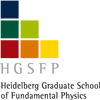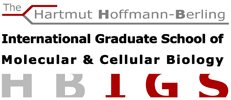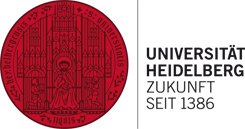Excellent Research Conditions for Scientists
In 2006 and 2007, Heidelberg University founded three graduate schools and two clusters of excellence within the framework of the German Excellence Initiative, with the aim of promoting top-level research and supporting junior scientists. Outfitted with state-of-the-art equipment, these offer outstanding PhD students and established scientists from all over the world excellent research conditions in highly interdisciplinary projects and research networks. That is one reason why many young academics of the graduate schools come to Heidelberg from abroad. International junior researchers find attractive conditions at the two clusters and the graduate schools in the form of programmes for PhD students, postdocs and heads of junior research groups, and advertisements for research groups.
Cluster of Excellence "Celullar Networks" (CellNetworks)
 Established in 2006, the CellNetworks cluster of excellence of Heidelberg University explores the structure, behaviour and dynamic changes of cellular networks. The cluster enables new forms of cooperation between researchers at the university and at other institutions and creates new links between scientific cultures. CellNetworks unites leading researchers from Heidelberg University, the European Molecular Biology Laboratory, the Max Planck Institute for Medical Research, the Max Planck Institute for Intelligent Systems, the German Cancer Research Center, the Central Institute of Mental Health in Mannheim, the Karlsruhe Institute of Technology and the Heidelberg Institute for Theoretical Studies. The cluster is also supported by industrial partners and the C.H.S. Foundation for the advancement of biomedical research.
Established in 2006, the CellNetworks cluster of excellence of Heidelberg University explores the structure, behaviour and dynamic changes of cellular networks. The cluster enables new forms of cooperation between researchers at the university and at other institutions and creates new links between scientific cultures. CellNetworks unites leading researchers from Heidelberg University, the European Molecular Biology Laboratory, the Max Planck Institute for Medical Research, the Max Planck Institute for Intelligent Systems, the German Cancer Research Center, the Central Institute of Mental Health in Mannheim, the Karlsruhe Institute of Technology and the Heidelberg Institute for Theoretical Studies. The cluster is also supported by industrial partners and the C.H.S. Foundation for the advancement of biomedical research.
Founded by 74 researchers, the network headed by Prof. Dr. Hans-Georg Kräusslich today counts 104 member scientists. So far, it has given rise to six completely new research groups and two professorships. The annual budget of CellNetworks, which is located in the Heidelberg BioQuant centre, is approximately ten million euros. CellNetworks conducts basic research, but also research aimed at medical applications and technical improvements. The project features an international network with a focus on Europe, the United States, Japan, India, Australia and Brazil. Junior scientists are supported by programmes for postdocs and heads of junior research groups. CellNetworks also tests new structures in the science management of the research network and supports its professionalisation. The project is characterised by an optimal research environment, interdisciplinary cooperation and a modern technical infrastructure.
Cluster of Excellence „Asia and Europe in a Global Context: Shifting Asymmetries in Cultural Flows“
 “Asia and Europe in a Global Context” is the title of an interdisciplinary network of researchers at Heidelberg University, that was started in October 2007. Today, the Cluster has about 200 researchers, who explore a complex historical relationship of great relevance for the global transformations of our time. In particular, they analyse the dynamics of transcultural interactions with focus on Asia and Europe. Its four research areas are “Government & Administration”, “Public Spheres”, “Health & Environment” (soon to be renamed into “Knowledge Systems”) and “Historicities & Heritage”. In addition, five Cluster professorships have been established, including Germany's first Chair of Global Art History.
“Asia and Europe in a Global Context” is the title of an interdisciplinary network of researchers at Heidelberg University, that was started in October 2007. Today, the Cluster has about 200 researchers, who explore a complex historical relationship of great relevance for the global transformations of our time. In particular, they analyse the dynamics of transcultural interactions with focus on Asia and Europe. Its four research areas are “Government & Administration”, “Public Spheres”, “Health & Environment” (soon to be renamed into “Knowledge Systems”) and “Historicities & Heritage”. In addition, five Cluster professorships have been established, including Germany's first Chair of Global Art History.
Highly remarkable is the Cluster's ability to combine cutting-edge research with teaching. Among others, it offers a Graduate Programme for Transcultural Studies. The structured doctoral programme provides monthly scholarships for three academic years and supports scholarship holders in framing their research through advanced courses and individual mentoring. In the first year, participants attend a number of thematically focused classes. The second year is intended for field research, while the third year is reserved for the write-up and presentation of the results. All classes are conducted in English. Half of the scholarships are reserved for young scholars from Asia.
Students from all over the world can now enrol in the master programme “Transcultural Studies” which has been initiated by the Cluster at Heidelberg University in 2011. Students are introduced to a transcultural research approach and its methods as well as to examples for cross-cultural exchange. During the two-year-programme, they select one of the three study foci: “Knowledge, Belief and Religion”, “Society, Economy and Governance” or “Visual, Media and Material Culture”. Applicants must hold a B.A. or equivalent in a discipline of the humanities or social sciences. Furthermore, they need to prove proficiency in English and two more languages.
Heidelberg Graduate School of Fundamental Physics (HGSFP)
 The Heidelberg Graduate School of Fundamental Physics (HGSFP) was established in Heidelberg in 2006 in recognition of the scientific excellence of the fundamental physics done at Heidelberg University. It provides a structured research environment for doctoral students, improves their education, monitors the quality, and offers possibilities for their individual development. The focus to date has been on basic research in the three traditional branches of the School: Astronomy and Cosmic Physics, Quantum Dynamics and Complex Quantum Systems, and Fundamental Interactions and Cosmology, each of which operates in close conjunction with a corresponding Max Planck Research School.
The Heidelberg Graduate School of Fundamental Physics (HGSFP) was established in Heidelberg in 2006 in recognition of the scientific excellence of the fundamental physics done at Heidelberg University. It provides a structured research environment for doctoral students, improves their education, monitors the quality, and offers possibilities for their individual development. The focus to date has been on basic research in the three traditional branches of the School: Astronomy and Cosmic Physics, Quantum Dynamics and Complex Quantum Systems, and Fundamental Interactions and Cosmology, each of which operates in close conjunction with a corresponding Max Planck Research School.
In particular, the International Max Planck Research School for Astronomy and Cosmic Physics at the University of Heidelberg (IMPRS-HD) is an independent part of the Heidelberg Graduate School of Fundamental Physics and forms the astronomy branch of the HGSFP. In addition to this Max Planck Research School, the students of the Max Planck Research School for Precision Tests of Fundamental Symmetries (IMPRS-PTFS) are also students of the HGSFP, and those who choose to study physics in the Max Planck Research School for Quantum Dynamics in Physics, Chemistry and Biology (IMPRS-QD) are also included in the HGSFP. The admission and the programme are coordinated with the three Max Planck Research Schools. International partnerships and exchange programmes with world-leading universities and institutes complement the comprehensive programme.
An international call for applications is usually made on the web site of the School in the latter half of the year for the coming academic year. Applicants must hold a Master’s degree in physics or equivalent qualification, and have a minimum grade of a B+. The language medium of the School is English.
Hartmut Hoffmann-Berling International Graduate School of Molecular and Cellular Biology (HBIGS)
 Coordinated by Heidelberg University, the Hartmut Hoffmann-Berling International Graduate School of Molecular & Cellular Biology (HBIGS) focuses since 2007 on the rapid developments in the life sciences and the resulting possibilities for medical and biotechnological applications. It houses research laboratories of the University, the Max-Planck-Institute for medical research (MPImF) and the German Cancer Research Center (DKFZ). Thanks to the cooperation of these institutions, PhD students at HBIGS benefit from excellent research conditions in more than 120 laboratories.
Coordinated by Heidelberg University, the Hartmut Hoffmann-Berling International Graduate School of Molecular & Cellular Biology (HBIGS) focuses since 2007 on the rapid developments in the life sciences and the resulting possibilities for medical and biotechnological applications. It houses research laboratories of the University, the Max-Planck-Institute for medical research (MPImF) and the German Cancer Research Center (DKFZ). Thanks to the cooperation of these institutions, PhD students at HBIGS benefit from excellent research conditions in more than 120 laboratories.
The research activities of students at the HBIGS focus on four subject areas: the basic molecular processes in the cell, cell differentiation and development, the biology of pathogenic organisms and molecular biotechnology. The students are taught and supported by 120 scientists that belong not only to the faculties of medicine and biosciences, but also related disciplines such as mathematics, chemistry, pharmacology and physics. These positive synergies increase the attractiveness of the structured PhD programme and support its aim of giving doctoral candidates an early start in their career.
HBIGS offers an English spoken PhD programme that leads the PhD students to do their PhD within three to three and a half years. This combines the benefits of a structured programme with the strengths of the classical Alexander –von-Humboldt PhD training concept. Intensive scientific tutoring and teaching by renowned researchers ensure that students receive a solid interdisciplinary education that meets the highest standards. In periodical guest lectures and retreats the students meet for an exchange and discussion of new scientific ideas. The Career Service offers students professional advice on career planning and individual professional orientation. In addition, the HBIGS caters to young families by offering support to its students during pregnancy and parental leave.
At this time, the school counts more than 300 PhD students from all over the world and has awarded over 40 PhD degrees. About 40 percent of the students are foreign nations, and more than the half women.
Heidelberg Graduate School of Mathematical and Computational Methods for the Sciences (HGS MathComp)
 Mathematical and computational modeling and simulation are widely regarded as the third pillar of science, complementing theory and experiment as an important tool in modern research. Educating young scientists and supervising their PhD projects in this highly complex area is the central aim of the doctoral school HGS MathComp, founded in 2007. The structures and measures for this educational task were developed and tuned over the last five years to achieve two goals simultaneously: accomplishing sound methodological education in applied mathematics and computer science and meeting the growing demand for tools and techniques tailored to the applications of Scientific Computing. In HGS MathComp, these application areas reach from astrophysics to systems biology and from advanced materials chemistry to network problems in commodity markets.
Mathematical and computational modeling and simulation are widely regarded as the third pillar of science, complementing theory and experiment as an important tool in modern research. Educating young scientists and supervising their PhD projects in this highly complex area is the central aim of the doctoral school HGS MathComp, founded in 2007. The structures and measures for this educational task were developed and tuned over the last five years to achieve two goals simultaneously: accomplishing sound methodological education in applied mathematics and computer science and meeting the growing demand for tools and techniques tailored to the applications of Scientific Computing. In HGS MathComp, these application areas reach from astrophysics to systems biology and from advanced materials chemistry to network problems in commodity markets.
Home of the MathComp graduate school is the Interdisciplinary Center for Scientific Computing (IWR), a cross section institution at Heidelberg University. IWR is not part of a department but embraces members from six different faculties and many other research institutions at Heidelberg such as the German Cancer Research Center (DKFZ) or the Heidelberg Institute for Theoretical Studies (HITS). Aim of the research at IWR is to find solutions to complex application problems with multi-layered questions in modeling, simulation, optimization and visualization. In close cooperation with industrial partners, modern methods are tested and fine-tuned; their application in industrial projects and the experiences that come with this practical test lead to the development of follow-up research questions. The education of our young researchers in the graduate school therefore keeps in mind both career options – university and industrial research and development. Doctoral students with top-notch education are received well by both job markets and conversely employees from our industrial partners hit the books again when attending HGS MathComp training courses on the latest tools and methods.

